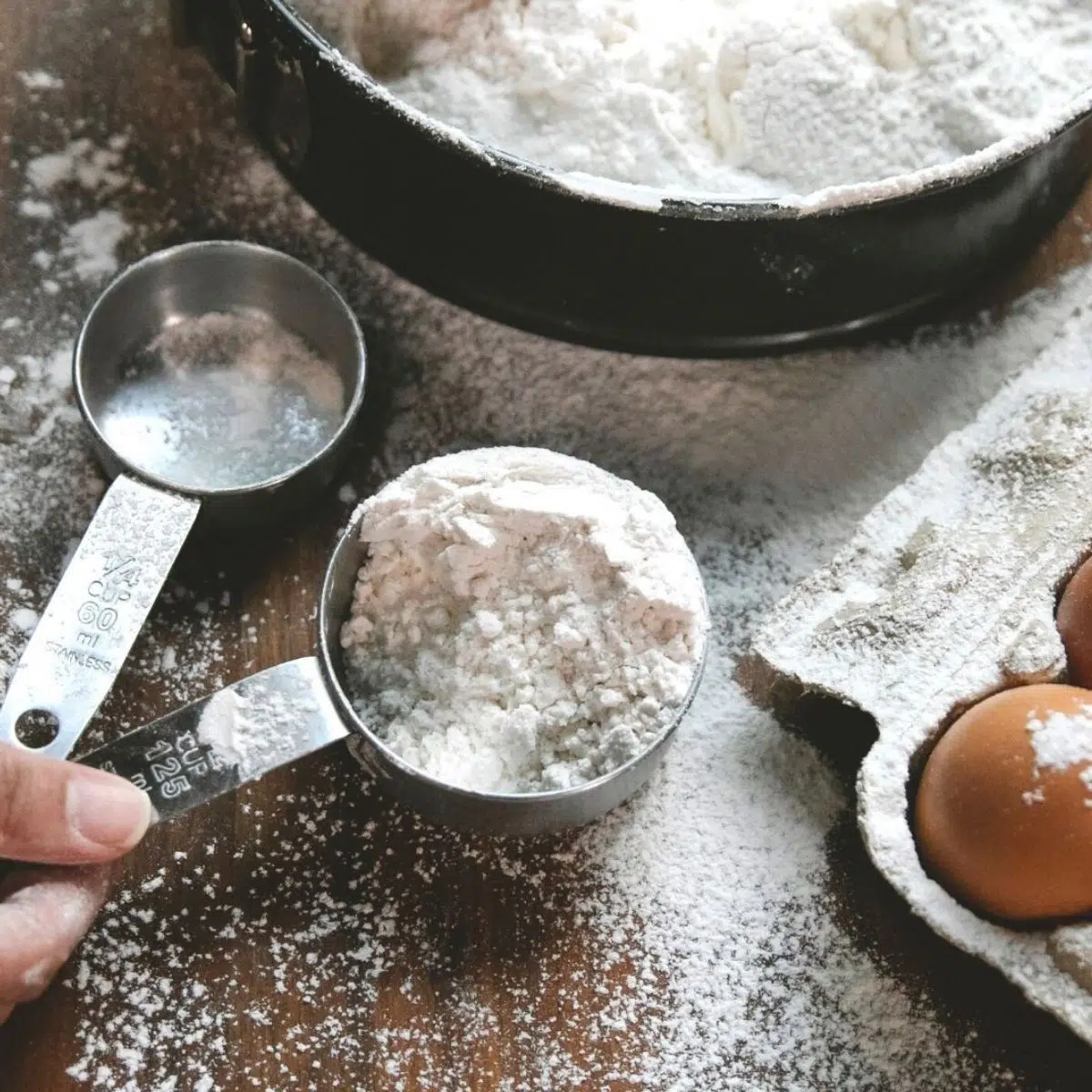For the best cake flour substitute and information on cake flour itself, check out this comprehensive post full of useful tips! Not only have we included a number of cake flour substitutions, but also a recipe for making homemade cake flour yourself!

Jump to:
- Cake Flour Alternatives
- What is Cake Flour?
- The Best Substitutes for Cake Flour
- 1. All-Purpose Flour
- 2. All-Purpose Flour + Cornstarch
- 3. All-Purpose Flour + Arrowroot Powder
- 4. Gluten-Free Flour Blend
- 5. Oat Flour + Arrowroot
- 6. Cassava Flour
- 7. Pastry Flour
- 8. Bread Flour
- 9. Homemade Cake Flour
- 📖 Recipe Card
- 💬 Comments & Reviews
Cake Flour Alternatives
Why does your recipe call for cake flour? Unless you are an avid baker, you may not realize there are differences between all-purpose flour and cake flour. This may have thrown you into a panic if you started baking a cake only to find that it calls for “cake flour.”
Not to worry! While cake flour is a special type of flour, it is not so special that you need to give up on baking your cake just because you don’t have it on hand.
There are plenty of amazing substitutes to use in its place! Moreover, some of these substitutes can also be used if you are trying to make your cake gluten-free.
What is Cake Flour?
Before looking at the substitutes, here are a few things to know about cake flour and what makes it different from other flour types.
Understanding these differences will help you understand why cake flour is being used in your recipe. Additionally, it will help you choose the best substitute.
If you saw a bowl of cake flour next to a bowl of all-purpose flour, you would not be able to tell the difference. Both flours are made from finely milled wheat. The main difference is the protein content. Cake flour has a lower protein content than all-purpose flour.
The amount of protein in flour impacts the formation of gluten. Basically, the higher the protein content the more gluten is formed. All-purpose flour has a higher protein content than cake flour (and bread flour has even more protein than all-purpose flour).
The cake flour's lower protein content means less gluten is formed. This results in lighter and fluffier baked goods. The ideal consistency for most cakes, cupcakes, and other baked goods.
The Best Substitutes for Cake Flour
When it comes to choosing the best substitute for cake flour it may simply be what alternative you have in your cupboard. It may also depend on what your nutritional goals are.
The great thing about cake flour is that while a substitute may not offer the exact light fluffy texture, most substitutes will not impact the overall taste. Therefore, while you may have a slightly denser cake, you will still get the same great flavor.
1. All-Purpose Flour
The easiest substitute is basic all-purpose flour. This is the most common type of flour to have in your pantry. It can be used for almost every recipe that calls for flour, hence the name “all-purpose.”
You may have even used all-purpose flour in making cakes in the past. It probably tasted delicious!
Using all-purpose flour will not change the flavor of your baked goods. It will change the overall texture though. All-purpose flour has a higher protein content than cake flour. Therefore, gluten is more quickly formed. The results are cakes and bread that are denser.
All-purpose flour can be used in a 1:1 ratio for cake flour in any recipe. In some cases, the higher protein content will absorb more liquid. Therefore, if your batter or dough looks too dry add a bit of extra liquid (water, milk, oil).
2. All-Purpose Flour + Cornstarch
If you have all-purpose flour but want to keep your baked goods light and fluffy, all it takes is the addition of another common kitchen ingredient. Corn starch.
Corn starch helps slow the formation of gluten. Therefore, when added to all-purpose flour it prevents the proteins in the flour from fully forming into gluten. This gives you a similar light texture that cake flour provides.
To replace 1 cup of cake flour, use a combination of ¾ cup all-purpose flour and 2 tablespoons corn starch. Add the corn starch to the bowl first and then pour the flour on top. Mix before adding to the rest of the ingredients.
This works well for any recipe that calls for cake flour, or that you want to lighten up a bit: quick breads, donuts, muffins, cakes.
3. All-Purpose Flour + Arrowroot Powder
If you prefer to not use corn-based products, like cornstarch, you can get a similar result by using arrowroot powder. Arrowroot powder is a grain-free and gluten-free powder that comes from a tropical plant. It works the same way as cornstarch in cooking and baking.
While arrowroot used to be harder to find, it is quite popular now. You can easily find it in most grocery stores on the baking aisle.
Use arrowroot powder in the same way that cornstarch is used above. Mix ¾ cup all-purpose flour with 2 tablespoons of arrowroot powder to replace 1 cup of cake flour.
4. Gluten-Free Flour Blend
With the need for gluten-free products growing every day, it is easy to find gluten-free flour in the grocery store. Every brand will vary in what is used to make the flour blend. Read the label to determine if the ingredients used are aligned with your nutritional goals.
Common ingredients include brown rice flour, potato flour, potato starch, coconut flour, oat flour, and almond flour. These blends are often higher in carbohydrates and lower in protein.
Even though the protein content may be low, the different blends will provide different textures to your baked goods. Some will be quite dense, while others will be lighter. If you are looking for a long-term gluten-free replacement for cake flour, try a couple of brands to find what works best for your recipes.
Read the label to see the suggested ratio for replacing wheat flour.
5. Oat Flour + Arrowroot
If you want an easy gluten-free flour replacement that you make at home, grab a canister of rolled oats. Toss a cup or two of oats in a blender or food processor. Grind until you have a finely milled flour.
Once you have your oat flour, mix it with arrowroot powder (or cornstarch). This will create a similar effect to the all-purpose flour mixtures above. However, your ratios will be different.
Use 1 cup of oat flour + 1 tablespoon arrowroot powder (or cornstarch) to replace 1 cup of cake flour.
While this will give you a lovely soft and chewy texture, it will impact the flavor. The oats will result in a baked good that has a nutty and toasted flavor.
If you don’t want to make your own oat flour, you can also buy oat flour at specialty grocery stores.
6. Cassava Flour
Another great gluten-free option, but one that is less common to have on hand, is cassava flour. Cassava flour is made from drying and processing cassava root (similar to yucca).
While you may not have this in your kitchen today, it is a great one to add to your pantry as a long-term substitute. It will not greatly impact the flavor of your recipes. However, depending on the recipe it may change the texture slightly.
Cassava can be used in a simple 1:1 ratio for recipes that call for cake flour. Be aware that cassava flour absorbs liquid much faster than cake flour. Therefore, you may want to add more liquid or start with less flour.
7. Pastry Flour
Pastry flour is another alternative that is less common to have on hand. Therefore, this may not be a quick substitute. If you plan to start exploring baking pastries though, you could pick up a bag of pastry flour to use in all your baking recipes.
Pastry flour is a specialty flour. It has an even lower protein content than cake flour. Due to this, it works best as a substitute in recipes that include a leavening agent like baking soda or baking powder.
You can use pastry flour in a 1:1 exchange for cake flour in recipes that you want to be extra light and fluffy.
8. Bread Flour
On the other end of the flour scale is bread flour. Bread flour is once again an alternative that you may not have on hand. However, with the rise of more people going back to baking bread at home in recent years – you may have some!
Bread flour is on the opposite end of the flour scale, from pastry flour. It has the highest protein content. It is even higher than all-purpose flour. This is what allows it to form gluten that results in deliciously dense and chewy bread.
Even with its higher protein content, bread flour can be used in a simple 1:1 exchange for cake flour. You can always start with a bit less though. Moreover, you may want to add some extra liquid if your batter or dough looks too heavy.
Due to its density, this option is suggested for quick breads, scones, or rich chocolate cakes and cupcakes.
9. Homemade Cake Flour
Unless you are a professional baker, you probably don’t make cakes too often. Therefore, you may not want to invest in a bag of cake flour.
However, when you do make a cake, you probably want the best texture! Use the directions in the recipe card below to make your homemade cake flour anytime you need it!
With so many easy cake flour substitutes, there's no need to worry should you ever run out! If you try my recipe for homemade cake flour, don't forget to come back and tell us how it worked out and what you made!
Do you love a recipe you tried? Please leave a 5-star 🌟rating in the recipe card below and/or a review in the comments section further down the page.
Stay in touch with me through social media @ Pinterest, Facebook, Instagram, or Twitter! Subscribe to the newsletter today (no spam, I promise)! Don't forget to tag me when you try one of my recipes!
📖 Recipe Card
Best Cake Flour Substitute: Homemade Cake Flour (+More Great Alternatives!)
Ingredients
- 2 tablespoon cornstarch
- 14 tablespoon all-purpose flour
(Note: 2x or 3x only changes the ingredient list)
Instructions
- Measure out 2 tablespoons of your cornstarch into a 1 cup dry measuring cup then top if off with your all-purpose flour. Spoon and level the flour into your measuring cup.
- Sift your cornstarch and AP flour combo together TWICE to ensure that the cornstarch is evenly distributed throughout your flour.
- Spoon and level one cup from this mixture to use in your baking recipes.
Notes
- Each serving is 1 cup of homemade cake flour.
- Measure each 1 cup of cake flour individually when your recipe calls for more than 1 cup of cake flour. I've found that this yields better results than combining the ingredients in larger bulk quantities.



Comments
No Comments